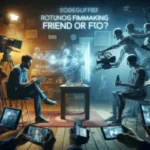As the silver screen flickers to life, it beckons us to a time when storytelling was infused with grandeur, artistry, and an undeniable sense of magic.
The Golden Age of Cinema, often romanticized as a bygone era of iconic stars, sweeping epics, and innovative filmmaking, has left an indelible mark on the fabric of entertainment. Yet, as we find ourselves navigating the complexities of a rapidly evolving digital landscape, one must ponder: is this nostalgic reverie merely a myth, a wistful longing for a past that can never return? Or could it signal a new beginning, inspiring a renaissance of creativity and innovation in the cinematic world? In this blog post, we will explore the rich history and cultural significance of this illustrious period while examining its influence on contemporary cinema. Join us as we delve into the essence of what made the Golden Age truly golden and uncover whether its legacy is a lingering echo of nostalgia or a vibrant spark for the future of film.
1. Defining the Golden Age of Cinema
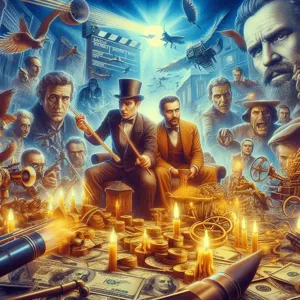
The term “Golden Age of Cinema” evokes a sense of nostalgia that resonates deeply with film enthusiasts and casual viewers alike. But what exactly defines this illustrious period? Generally, the Golden Age of Cinema is considered to span from the late 1920s to the early 1960s, a time when Hollywood emerged as a dominant force in global entertainment and storytelling. It was an era marked by the rise of the studio system, where major film studios like MGM, Warner Bros., and Paramount Pictures wielded immense influence over production, distribution, and marketing.
During this time, groundbreaking technological advancements transformed the cinematic landscape. The transition from silent films to “talkies” revolutionized how stories were told, allowing for dialogue, music, and sound effects to enrich the viewing experience. Iconic films such as “The Jazz Singer” (1927) and “Gone with the Wind” (1939) not only captivated audiences but also set new standards for filmmaking.
This period also saw the emergence of legendary stars who became cultural icons, from the glamourous allure of Marilyn Monroe to the rugged charisma of John Wayne. These actors, along with directors like Alfred Hitchcock and Frank Capra, created a unique tapestry of genres that ranged from the sweeping epics of romance and adventure to the raw authenticity of film noir. The narratives explored in this era often reflected societal values, political climates, and the hopes and fears of a nation grappling with the aftermath of the Great Depression and the complexities of World War II.
While the Golden Age is often romanticized, it was also a time of significant challenges, including the strict enforcement of the Production Code, which imposed moral guidelines on content. However, it was this very tension between creativity and constraint that sparked innovation and artistic expression, leading to the timeless classics we cherish today. As we delve deeper into this enchanting period, we must ponder whether it remains a nostalgic myth or serves as a foundation for a new beginning in the ever-evolving world of cinema.
2. Historical Context: The Rise of Hollywood
To fully appreciate the Golden Age of Cinema, one must first delve into the historical context that gave rise to Hollywood as a cinematic powerhouse. The early 20th century marked a significant turning point in both technology and culture, laying the groundwork for the film industry we know today.
In the aftermath of World War I, America experienced a surge of prosperity and modernization. The 1920s, often dubbed the “Roaring Twenties,” saw a cultural shift characterized by a desire for escapism and entertainment. People were drawn to the allure of the silver screen, seeking refuge from the harsh realities of life. This burgeoning demand for films coincided with advancements in motion picture technology, including the introduction of sound in the late 1920s. The first “talkie,” *The Jazz Singer*, not only revolutionized the industry but also solidified Hollywood’s dominance as the epicenter of film production.
Simultaneously, the Great Depression of the 1930s created a paradox where, despite economic hardship, cinema became a vital source of affordable entertainment. Movie palaces opened their doors, offering lavish experiences that transported audiences into fantastical worlds. This era produced iconic films and stars, such as Clark Gable, Greta Garbo, and Judy Garland, who became cultural touchstones and symbols of hope during trying times.
As the 1940s rolled in, World War II further shaped Hollywood’s narrative, with films often serving as propaganda or morale boosters for both soldiers and civilians. The industry responded to the public’s needs, crafting stories that resonated with the zeitgeist, from patriotic epics to romantic dramas that provided solace amidst the chaos of war.
In this vibrant historical context, Hollywood transformed from a fledgling industry to a global phenomenon, establishing the foundation for the Golden Age of Cinema. Understanding this backdrop not only enriches our appreciation for the era’s films but also highlights the way cinema has always mirrored societal changes, reflecting both the triumphs and tribulations of its time. As we explore this golden period, we must ask ourselves: was it merely a nostalgic myth, or did it indeed herald a new beginning for the art of storytelling?
3. Iconic Films and Filmmakers of the Golden Age
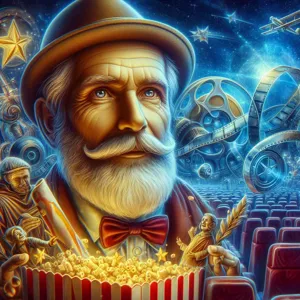
The Golden Age of Cinema, spanning roughly from the late 1920s to the early 1960s, was a period characterized by remarkable creativity and groundbreaking storytelling that laid the foundation for modern filmmaking. This era birthed a plethora of iconic films that not only captivated audiences of their time but also left an indelible mark on the cinematic landscape, influencing countless filmmakers and genres to this day.
At the heart of this golden age were legendary filmmakers whose visions and innovations transformed the way stories were told on screen. Directors like Alfred Hitchcock, known as the “Master of Suspense,” crafted thrillers that played with audience expectations, while Frank Capra’s heartwarming narratives captured the essence of the American spirit. Meanwhile, Orson Welles, with his groundbreaking work in “Citizen Kane,” challenged conventional storytelling techniques, presenting a complex portrait of power and ambition that remains a touchstone in film studies.
The films produced during this time were not just entertainment; they were cultural phenomena that reflected societal values and challenges. Classics like “Gone with the Wind” and “Casablanca” explored themes of love, sacrifice, and resilience amidst the backdrop of war and uncertainty. Meanwhile, musicals such as “Singin’ in the Rain” and “The Wizard of Oz” transported audiences into vibrant worlds filled with joy and imagination, showcasing the artistic possibilities of color and sound in cinema.
The Golden Age also introduced audiences to unforgettable stars whose charisma and talent captured hearts worldwide. Icons like Audrey Hepburn, Humphrey Bogart, and Marilyn Monroe became symbols of their era, their performances etched into the annals of film history. These actors brought to life characters that resonated with viewers, evoking laughter, tears, and a sense of nostalgia that continues to draw fans to their films.
As we reflect on this era, it becomes clear that the Golden Age of Cinema was not merely a myth of nostalgia but a profound period of artistic achievement and innovation. Its legacy endures, inspiring contemporary filmmakers to push boundaries and create stories that resonate with audiences today. Whether through remakes, homages, or original works that echo the themes of the past, the influence of the Golden Age remains as potent as ever, reminding us of the timeless power of cinema to evoke emotion and tell the human story.
4. Cultural Impact: How Cinema Shaped Society
The cultural impact of cinema throughout its history cannot be overstated; it has served as both a mirror and a mold for societal values, aspirations, and tensions. From the early silent films that captured the essence of human emotion without uttering a single word, to the grand epics that chronicled the struggles and triumphs of entire generations, cinema has consistently influenced and reflected the zeitgeist of its time.
In the 1920s and 1930s, the advent of sound revolutionized the film industry and transformed cinema into a powerful form of mass communication. Movies became an escape from the harsh realities of the Great Depression, offering audiences a chance to dream and experience lives far removed from their own. The glamorous world of Hollywood, with its larger-than-life stars, not only shaped popular culture but also set standards of beauty and success that many aspired to emulate.
As the decades rolled on, cinema also became a vehicle for social change. Films like “Guess Who’s Coming to Dinner” and “The Graduate” in the 1960s confronted racial tensions and challenged societal norms, pushing audiences to rethink their perceptions of race, class, and gender. The emergence of independent cinema in the 1990s further democratized storytelling, giving voice to marginalized perspectives and expanding the narrative scope of what cinema could achieve.
Today, as we navigate the rapid evolution of technology and the global marketplace, cinema continues to reflect and shape society. Streaming platforms have not only revolutionized how we consume films but have also democratized access to diverse narratives from around the world. With the rise of international cinema, audiences are exposed to stories that challenge their worldviews and foster empathy across cultures.
In this golden age of cinema, we stand at a crossroads. Are we witnessing a nostalgic myth, a longing for the past, or a new beginning where the cultural significance of film is redefined in an ever-evolving landscape? As we explore the profound ways cinema has shaped society, it becomes clear that its impact is both enduring and transformative, poised to continue influencing generations to come.
5. The Myths Surrounding the Golden Age
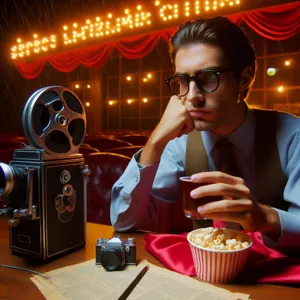
The Golden Age of Cinema often conjures images of glamorous Hollywood stars, lavish sets, and unforgettable films that have stood the test of time. However, beneath the shimmering surface lies a complex tapestry woven with myths and misconceptions that can obscure the reality of that era.
One prevalent myth is the notion that this period was a time of uninterrupted artistic brilliance. While it’s true that many masterpieces emerged, the Golden Age was also marked by strict studio control, limited creative freedoms for filmmakers, and a narrow range of stories that were deemed commercially viable. The studios, often run by powerful moguls, prioritized profit over innovation, stifling the voices of many talented artists who struggled to break free from the constraints of the system.
Another myth romanticizes the lifestyle of the stars, suggesting that they lived in a constant state of glamour and happiness. In reality, many actors faced immense pressure to maintain their public personas, often battling personal demons exacerbated by the industry’s relentless scrutiny. Behind the velvet ropes of awards ceremonies and the flash of camera bulbs lay stories of exploitation, mental health struggles, and the burden of fame that went largely unacknowledged at the time.
Furthermore, the idea that the Golden Age was a golden standard for diversity and representation is another misconception that deserves scrutiny. While some iconic films have become cultural touchstones, the era was notoriously exclusionary, with few opportunities for actors of color, women, and LGBTQ+ individuals. The narratives that dominated the screen often perpetuated stereotypes and failed to reflect the rich tapestry of human experience.
As we peel back the layers of these myths, it becomes clear that the Golden Age of Cinema was not just a singular moment of brilliance but a complex era filled with contradictions and challenges. Understanding these myths allows us to appreciate the true essence of cinema’s evolution and recognize the strides we continue to make toward a more inclusive and representative film industry today. In revisiting this period, we can acknowledge its achievements while critically examining its shortcomings, paving the way for a cinematic future that honors the diverse voices of our world.
6. The Decline of Classic Hollywood: Factors at Play
The decline of classic Hollywood represents a pivotal chapter in the history of cinema, shaped by a multitude of factors that converged to transform the landscape of filmmaking as we know it. At the core of this decline was the rise of television in the mid-20th century, which pulled audiences away from theaters and into their living rooms. This seismic shift not only changed viewing habits but also altered the economic viability of the film industry. The allure of weekly shows and the comfort of home entertainment led to sharp declines in ticket sales, forcing studios to adapt in ways they never anticipated.
Compounding this shift were the social and cultural upheavals of the 1960s and 70s. The counterculture movement, the civil rights struggle, and the burgeoning feminist movement all pushed for narratives that reflected a broader spectrum of human experience, straying from the glamorized depictions of life that classic Hollywood was known for. Audiences began to crave authenticity and representation, leading to a demand for stories that challenged the status quo rather than reinforced it.
Additionally, the economic pressures of the time played a crucial role. The Hollywood studio system, which had thrived on a star-centric model, began to crumble as independent filmmakers emerged, bringing fresh perspectives and innovative storytelling techniques. The rise of blockbuster films, characterized by their special effects and action-packed narratives, also signaled a departure from the character-driven dramas of yesteryear, further distancing audiences from classic cinematic themes.
As we reflect on these factors, it becomes clear that the decline of classic Hollywood was not merely a fading of the golden age but a complex interplay of technological, cultural, and economic forces. This period of transition, while marked by loss, also paved the way for new voices and visions to flourish in the modern film industry, questioning whether the era we once hailed as golden was indeed a nostalgic myth or the catalyst for a vibrant new beginning.
7. The Evolution of Film Technology and Its Influence
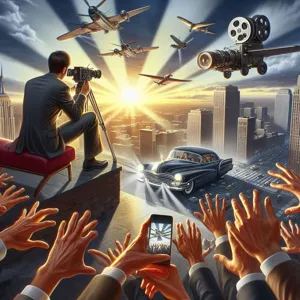
The evolution of film technology has been a driving force behind the cinematic experience, transforming how stories are told and how audiences engage with them. From the early days of silent films, where flickering images danced across the screen, to the groundbreaking advent of color and sound, each technological advancement has redefined the boundaries of creativity. Today, we find ourselves in an era where digital effects and high-definition imagery create breathtaking worlds that were once confined to the imagination.
The introduction of CGI (computer-generated imagery) revolutionized the industry, allowing filmmakers to construct entire universes and bring fantastical creatures to life with remarkable authenticity. This innovation has not only enhanced the visual spectacle of films but has also expanded the types of narratives that can be explored. Audiences now expect immersive experiences that transport them beyond the limitations of reality, a standard that continues to evolve with advancements like virtual reality (VR) and augmented reality (AR).
Moreover, the influence of technology extends beyond the screen. The rise of streaming platforms has fundamentally altered the way we consume films, providing unprecedented access to a vast array of content. This shift has made it easier for independent filmmakers to showcase their work, thereby diversifying the narratives available to audiences and challenging the traditional blockbuster model. As viewers increasingly seek out personalized experiences, the film industry must adapt, embracing new formats and distribution methods to meet their evolving tastes.
As we stand at this intersection of nostalgia and innovation, it becomes clear that the golden age of cinema is not merely a relic of the past but a continuously unfolding journey. With each technological leap, filmmakers are not only honoring the legacy of those who came before but are also inviting us to witness the dawn of new storytelling possibilities, making the future of cinema an exhilarating prospect.
8. Comparisons: Golden Age vs. Modern Cinema
When we delve into the heart of cinema’s evolution, the comparisons between the Golden Age of Hollywood and modern cinema reveal both stark contrasts and surprising continuities. The Golden Age, spanning from the late 1920s to the early 1960s, was characterized by its lavish productions, star-studded casts, and the emergence of the studio system, which produced timeless classics that shaped the cultural landscape. Films like *Gone with the Wind* and *Casablanca* not only entertained but also reflected the social mores and collective struggles of their times, offering audiences a sense of escapism amidst the realities of life.
In contrast, modern cinema thrives on diversity and innovation, driven by technological advancements and shifting audience preferences. Today’s filmmakers often embrace independent storytelling and genre-bending narratives that challenge traditional norms. The rise of streaming platforms has democratized access to films, allowing for a plethora of voices and stories that were once sidelined in the more homogenized landscape of yesteryear. While the Golden Age was marked by grandiose storytelling and iconic performances, modern cinema often prioritizes personal narratives and raw authenticity, appealing to a more global audience.
Yet, amidst these differences, there remains a thread that binds the two eras: the enduring power of storytelling. Whether through the glitzy glamour of the 1940s or the gritty realism of today’s films, the fundamental human experience at the core of cinema remains unchanged. As we look back at the Golden Age, we can appreciate the craftsmanship and artistry that laid the groundwork for contemporary cinema. In this way, rather than viewing the Golden Age as a myth overshadowed by modernity, it becomes clear that it is a foundational pillar upon which the rich tapestry of today’s film industry is built. This exploration of comparisons not only ignites nostalgia but also invites us to celebrate the evolution of storytelling in cinema, suggesting that we are not at the end of an era but rather at the dawn of a new beginning.
9. Revivals and Trends in Contemporary Filmmaking
The landscape of contemporary filmmaking is a vibrant tapestry woven with threads of nostalgia and innovation, where revivals of classic genres and trends create a fascinating dialogue between past and present. As filmmakers delve into the rich history of cinema, we’re witnessing a resurgence of styles that evoke the golden age while infusing them with modern sensibilities. From the sweeping romanticism of epic dramas to the gritty realism of noir thrillers, these revivals are not mere remakes; they are reinterpretations that breathe new life into beloved narratives.
One notable trend is the revival of musical films, reminiscent of the dazzling numbers that once lit up the silver screen. With hits like “La La Land” and the recent adaptations of Broadway classics, contemporary cinema is once again embracing the joy of song and dance, captivating audiences with vibrant visuals and heartfelt performances. Similarly, the resurgence of thrillers and horror films taps into the genre’s historical roots while exploring contemporary fears, often reflecting societal anxieties in ways that resonate deeply with modern viewers.
Moreover, the rise of streaming platforms has facilitated a renaissance in storytelling formats, allowing filmmakers to experiment with episodic narratives that mirror the serialized structures of yesteryear. This shift not only pays homage to classic television but also offers a fresh canvas for character development and intricate plots, inviting audiences to engage with stories over extended periods.
In addition, contemporary filmmakers are increasingly drawing inspiration from global cinema, leading to a broader palette of influences and narratives. This cross-pollination of ideas enriches the cinematic landscape, as directors and writers infuse their works with diverse cultural perspectives, creating films that are both familiar and refreshingly new.
Ultimately, the current revival of trends in filmmaking suggests that the golden age of cinema is not just a nostalgic myth but rather a foundation upon which a new and exciting era is being built. By honoring the past while boldly innovating for the future, today’s filmmakers are crafting a cinematic experience that celebrates the art form’s rich heritage while pushing the boundaries of creativity. As we explore this dynamic evolution, it becomes clear that the heart of cinema continues to beat strong, inviting audiences to join in the ever-unfolding story of film.
10. The Role of Streaming Platforms in Film Distribution
The emergence of streaming platforms has fundamentally transformed the landscape of film distribution, ushering in a new era that challenges the traditional paradigms of cinema. Once dominated by brick-and-mortar theaters, the film industry now finds itself at a crossroads, where the allure of watching a movie from the comfort of one’s home competes with the grandeur of the silver screen. Platforms like Netflix, Amazon Prime, and Disney+ have democratized access to films, allowing audiences worldwide to discover indie gems alongside blockbuster hits, often at the click of a button.
This shift has sparked a resurgence in diverse storytelling, as streaming services actively seek out unique voices and varied narratives that may have struggled to find a foothold in conventional cinema. For filmmakers, these platforms offer unprecedented opportunities for distribution and audience engagement. No longer bound by geographical limitations, films can now reach global viewers, cultivating a sense of community among fans who can discuss and share their insights in real-time.
Moreover, the power dynamics within the industry have shifted significantly. Streaming platforms often bypass traditional gatekeepers, allowing creators more creative freedom and control over their work. This newfound autonomy has led to a flourishing of innovative content that pushes boundaries and challenges societal norms, echoing the spirit of the Golden Age of Cinema when groundbreaking films sparked cultural conversations.
However, this evolution raises questions about the future of theatrical releases. As major studios increasingly invest in exclusive streaming content, the viability of cinemas as the primary venue for film exhibition comes into question. Will the communal experience of watching a film in a theater become a nostalgic relic of the past, or can it coexist with the convenience of streaming?
Ultimately, the role of streaming platforms in film distribution is both a catalyst for change and a reflection of an ever-evolving audience. As we navigate this new terrain, the debate continues: Is this the golden age of cinema, or are we witnessing the beginning of a new chapter in the storied history of film?
11. Nostalgia in Film: Why We Long for the Past
Nostalgia in film serves as a powerful lens through which we view both our personal histories and collective memories. It evokes a longing for a simpler time, often characterized by an idealized past that feels comforting and familiar. In an age marked by rapid technological advancements and societal changes, many viewers find solace in the rich textures, storytelling styles, and cultural references of earlier cinema. The Golden Age of Hollywood, with its glamorous stars, sweeping narratives, and larger-than-life productions, provides a stark contrast to today’s often fragmented and fast-paced media landscape.
This yearning for the past manifests in various ways across contemporary films. Filmmakers frequently draw inspiration from classic genres, resurrecting the aesthetics of film noir, musicals, or romantic comedies, inviting audiences to relive those moments on the silver screen. Whether it’s the soft glow of Technicolor or the haunting melodies of orchestral scores, these cinematic elements stir emotions that resonate with our experiences and memories.
Moreover, nostalgia functions as a bridge connecting generations. Older viewers are transported back to their youth, while younger audiences are introduced to the timeless themes and archetypes that continue to shape storytelling. This cross-generational appeal fosters a shared cultural dialogue, as filmgoers bond over the common threads of love, loss, adventure, and hope that have defined humanity for decades.
The phenomenon of nostalgia is not merely a longing for what was; it also serves as a critique of the present. As we grapple with the complexities of modern life, films that harken back to a bygone era offer a reprieve, allowing us to escape into worlds filled with hope and possibility. This delicate interplay between past and present raises questions about our values and aspirations, urging us to reflect on where we have been and where we are headed.
In this era of cinematic reinvention, nostalgia becomes a means of exploration rather than mere sentimentality. It challenges filmmakers to reinterpret classic narratives through contemporary lenses, ultimately paving the way for new beginnings while honoring the rich tapestry of cinema’s history. As we navigate this golden age of film, we find that nostalgia is not just a wistful reminiscence; it’s a dynamic force that shapes our understanding of art, culture, and ourselves.
12. The Future of Cinema: New Genres and Perspectives
As we stand on the precipice of a new era in filmmaking, the future of cinema brims with promise, innovation, and the potential for unprecedented growth in storytelling. The landscape is evolving, with filmmakers exploring new genres that reflect the complexities and nuances of contemporary life. From the rise of interactive narratives that engage viewers in unprecedented ways to the blending of traditional genres with digital artistry, the possibilities are limitless.
In recent years, we’ve witnessed the emergence of hybrid genres that defy categorization, such as sci-fi horror and romantic thrillers, which push boundaries and invite audiences to experience familiar tropes through fresh lenses. Moreover, the integration of technology—think augmented reality and virtual reality—offers immersive experiences that transport viewers into the heart of the story, blurring the lines between spectator and participant.
But it’s not just about new genres; it’s also about amplifying diverse voices and perspectives. Filmmakers from underrepresented backgrounds are gaining visibility, crafting narratives that resonate with a broader spectrum of experiences. This shift is not only refreshing the cinematic landscape but also fostering empathy and understanding among audiences. Stories that delve into cultural histories, social justice issues, and personal journeys are becoming more prevalent, allowing cinema to serve as a mirror reflecting the world’s richness and challenges.
As we look ahead, the potential for storytelling in cinema is vast and vibrant. The convergence of technology, creativity, and diverse perspectives will not only redefine how stories are told but also who gets to tell them. In this golden age of cinema, we are not merely spectators; we are witnesses to a transformative journey that celebrates the power of film to inspire, connect, and provoke thought in a rapidly changing world. The future is not just a continuation of the past; it’s a bold new beginning, and the stories waiting to be told are as expansive as our imaginations allow.
13. Voices and Stories: Diversity in Modern Filmmaking
In the landscape of modern filmmaking, the call for diverse voices and stories has never been more pronounced. As audiences increasingly seek representation and authenticity on screen, filmmakers are stepping up to tell narratives that reflect the rich tapestry of human experience. This shift is not just a trend; it’s a transformative movement reshaping the very fabric of cinema.
Gone are the days when Hollywood primarily showcased a narrow range of perspectives, often sidelining underrepresented groups. Today, filmmakers from various backgrounds—be it race, gender, sexuality, or ability—are bringing their unique narratives to the forefront. This diversity enriches storytelling, offering fresh angles and insights that resonate with a wider audience. Films like “Black Panther,” “Parasite,” and “Everything Everywhere All at Once” have not only garnered critical acclaim but also shattered box office records, proving that inclusive storytelling is not just good ethics—it’s good business.
Moreover, the rise of streaming platforms has democratized access to content creation, empowering voices that were once marginalized. Independent filmmakers are harnessing digital tools to produce and distribute their films, allowing for a broader array of stories to be told. This newfound freedom encourages experimentation and innovation, leading to a renaissance of creativity that reflects contemporary society’s complexities.
As we navigate this exciting era of cinema, it’s crucial to recognize the importance of diverse voices in shaping the stories we tell. These narratives serve as mirrors that reflect our collective humanity, fostering empathy and understanding across cultures. The golden age of cinema is not merely a nostalgic myth; it is a new beginning, one where every voice matters, and every story has the potential to leave an indelible mark on the world. By championing diversity in filmmaking, we pave the way for a richer, more vibrant cinematic landscape that honors the multiplicity of experiences that define us all.
14. Is There a New Golden Age on the Horizon?
As we stand at the crossroads of innovation and nostalgia, the question looms large: is there a new golden age of cinema on the horizon? The signs are tantalizing. Streaming platforms have revolutionized the way audiences consume content, allowing filmmakers unparalleled freedom to explore diverse narratives that might not have thrived in the traditional box office model. This democratization of storytelling has given rise to a plethora of voices from underrepresented communities, leading to a richer tapestry of cinema that reflects the world in all its complexities.
At the same time, advancements in technology—think virtual reality, augmented reality, and sophisticated CGI—are pushing the boundaries of what stories can be told and how they are experienced. These tools not only enhance visual storytelling but also invite audiences to immerse themselves in narratives like never before. The cinematic landscape is evolving, with filmmakers experimenting with form and content, creating a vibrant culture of innovation.
However, some industry veterans caution against the fervent optimism, arguing that the sheer volume of content can dilute quality. With an overwhelming number of films and shows competing for attention, will genuine artistic expression be lost in the noise? Yet, amidst this vast sea of content, we are witnessing the emergence of passionate indie films and auteur-driven projects that echo the creativity of classic eras, suggesting that while the landscape may have changed, the potential for greatness remains.
As we ponder this question, it’s important to consider the audience’s evolving preferences. The rise of global cinema and the growing importance of cultural narratives are reshaping what it means to be a successful film today. It seems that with every passing year, audiences are more eager to engage with stories that resonate personally and culturally, heralding a new era of cinematic experiences that are both reflective and transformative.
In this dynamic environment, the golden age of cinema could very well be in the making, fueled by the interplay of technology, creativity, and an ever-expanding audience. As we navigate this exciting terrain, one thing is certain: the love for storytelling will continue to thrive, and the next wave of cinematic brilliance may just be around the corner, waiting to enchant a new generation of film lovers.
15. Conclusion: What the Past Can Teach Us About the Future of Film
As we draw the curtain on our exploration of the Golden Age of Cinema, it’s essential to reflect on the lessons that this remarkable era imparts for the future of film. The enchanting world of classic cinema was not merely a product of its time, but a confluence of creativity, innovation, and the indomitable spirit of storytelling. It taught us that films have the power to transcend mere entertainment, serving as cultural touchstones, societal mirrors, and vehicles for profound emotional connections.
Today, as we navigate a rapidly evolving media landscape dominated by streaming platforms and digital distribution, we must not forget the fundamentals that made the Golden Age so impactful. The art of storytelling remains paramount; compelling narratives combined with rich character development have always captured the hearts of audiences. Filmmakers should draw inspiration from the meticulous craftsmanship of the past, where every frame was carefully curated, every score meticulously composed, and every performance steeped in authenticity.
Additionally, the collaborative spirit that defined the Golden Age is a vital lesson for contemporary filmmakers. It reminds us that the magic of cinema is often born from the synergy of diverse talents—directors, writers, actors, and technicians working in harmony to create a cohesive vision. In an industry that has become increasingly fragmented, fostering collaboration across disciplines can lead to groundbreaking innovations and fresh perspectives.
Moreover, we should embrace the nostalgia of the past while also championing new voices and stories that reflect our modern world. The Golden Age was characterized by its bold narratives and genre-defining works, and today’s filmmakers have the opportunity to explore uncharted territories, challenge conventions, and elevate underrepresented narratives. By acknowledging the triumphs and shortcomings of this golden era, we can pave the way for a more inclusive and dynamic future in film.
In conclusion, the Golden Age of Cinema is not merely a nostalgic myth but a cornerstone upon which we can build the future. By understanding its enduring legacy and applying its lessons to our current practices, we can ensure that the magic of film continues to inspire, entertain, and provoke thought for generations to come. The reel of cinema spins ever onward, and it is our responsibility to honor the past while boldly creating the future.
As we reflect on the captivating journey through the Golden Age of Cinema, it becomes clear that this era was not merely a nostalgic myth but a profound foundation for the future of film. The rich tapestry of storytelling, groundbreaking innovations, and unforgettable performances continue to inspire filmmakers and audiences alike. While some may reminisce about the past with a sense of longing, we must also recognize the exciting possibilities that lie ahead. The lessons learned from this iconic period can guide the new wave of creativity and artistry, reminding us that every ending is also a new beginning. So, as we celebrate the magic of classic films, let us also embrace the evolution of cinema, where the past meets the present, and the possibilities are as limitless as our imagination. Thank you for joining us on this cinematic exploration; we look forward to discovering what the future holds for this ever-evolving art form.

